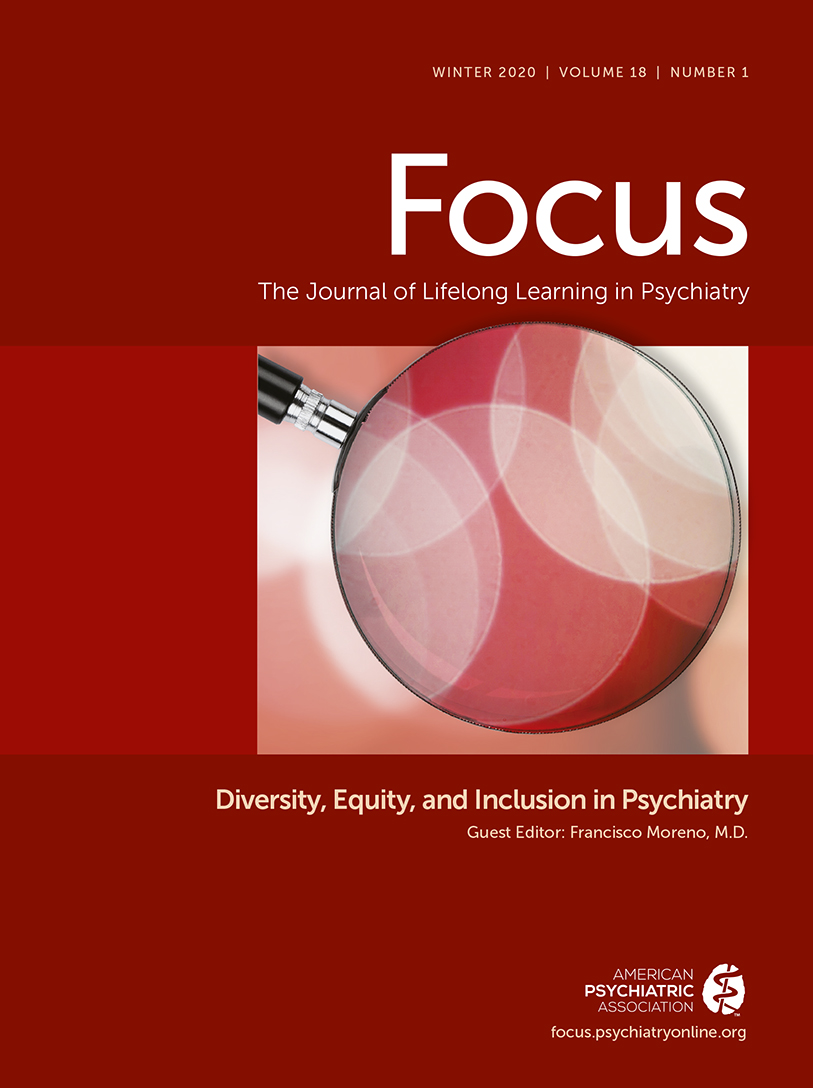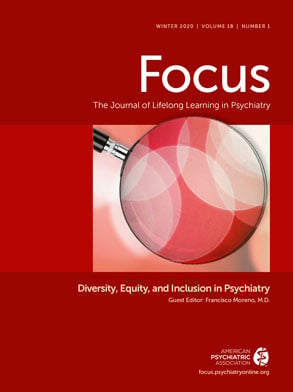Diversity is the one true thing we all have in common. Celebrate it every day.
— Author Unknown
The 2002 Institute of Medicine (IOM) report,
Unequal Treatment: Confronting Racial and Ethnic Disparities in Healthcare, brought into stark focus the issues of inequities based on minority status in health care services. The IOM report concluded that, “Bias, stereotyping, prejudice, and clinical uncertainty on the part of healthcare providers may contribute to racial and ethnic disparities in healthcare” (
1). Persons in racial and ethnic minority groups were found to receive lower-quality health care than whites received, even when they were insured to the same degree and when other health care access-related factors, such as the ability to pay for care, were the same (
1). Clients in minority groups were also not getting their needs met in mental health treatment (
2,
3). The IOM report was a primary impetus for the cultural competence movement in health care.
Cultural competency emphasizes the need for health care systems and providers to be aware of, and responsive to, patients’ cultural perspectives and backgrounds (
4). Patient and family preferences, values, cultural traditions, language, and socioeconomic conditions are respected. The concepts of cultural competence and patient-centered care intersect in meaningful ways. The IOM’s
Crossing the Quality Chasm (
5) document defines patient-centered care as “providing care that is respectful of, and responsive to, individual patient preferences, needs, and values, and ensuring that patient values guide all clinical decisions” (p. 3). Both patient centeredness and cultural competence are needed in striving to improve health care quality (
6,
7). To deliver individualized, patient-centered care, a provider must consider patients’ diversity of lifestyles, experience, and perspectives to collaborate in joint decision making. Patient-centered care has the potential to enhance equity in health care delivery; cultural sensitivity may likewise enhance patient-centered care (
6). Indicators of culturally sensitive health care identified in focus groups of low-income African-American, Latino American, and European American primary care patients included interpersonal skills, individualized treatment, effective communication, and technical competence (
8). The U.S. Office of Minority Health has set national standards for culturally and linguistically appropriate health care services (
9). The Principal Standard is that health care must “provide effective, equitable, understandable and respectful quality care and services that are responsive to diverse cultural health beliefs and practices, preferred languages, health literacy and other communication needs” (p. 1).
Five key predictors of culture-related communication problems have been identified in the literature: cultural differences in explanatory models of health and illness, differences in cultural values, cultural differences in patients’ preferences for doctor–patient relationships, racism and perceptual biases, and linguistic barriers (
10). Physicians are often poorly cognizant of how their communication patterns may vary with respect to the characteristics of the individual they are treating (
11). This unconscious preconceptualization is termed
implicit bias, which refers to the attitudes or stereotypes that affect understanding, actions, and decisions in an unconscious manner (
12). All people experience these—even those who strive to maintain a multicultural orientation and openness to diversity. Health care providers must openly reflect on and discuss issues of the patient’s culture, including ethnicity and race, gender, age, class, education, religion, sexual orientation and identification, and physical ability, along with the unequal distribution of power and the existence of social inequities, to effectively coconstruct a treatment plan that is patient centered and culturally sensitive.
Merging Cultural Competence With Cultural Humility
Cultural humility (
13) involves entering a relationship with another person with the intention of honoring their beliefs, customs, and values. It entails an ongoing process of self-exploration and self-critique combined with a willingness to learn from others. Authors have contrasted cultural humility with the concept of cultural competence. Cultural competence is characterized as a skill that can be taught, trained, and achieved and is often described as a necessary and sufficient condition for working effectively with diverse patients. The underlying assumption of this approach is that the greater the knowledge one has about another culture, the greater the competence in practice. The concept of cultural humility, by contrast, de-emphasizes cultural knowledge and competency and places greater emphasis on lifelong nurturing of self-evaluation and critique, promotion of interpersonal sensitivity and openness, addressing power imbalances, and advancement of an appreciation of intracultural variation and individuality to avoid stereotyping. Cultural humility encourages an interpersonal stance that is curious and other-oriented (
14,
15).
The infusion of cultural humility into cultural knowledge has been coined
competemility: the merging of competence and humility (
16). Cultural competemility is defined as “the synergistic process between cultural humility and cultural competence in which cultural humility permeates each of the five components of cultural competence: cultural awareness, cultural knowledge, cultural skill, cultural desire, and cultural encounters” (
16). The competemility position allows a meaningful connection with each patient as a unique individual, with diverse perspectives, culture, and lifestyles. Cultural competemility necessitates a consciousness of the limits of one’s knowledge and the awareness of the ever-present potential for unconscious biases to limit one’s viewpoint (
15,
16).
Practicing Cultural Competence and Cultural Humility
Cultural competence, cultural humility, and patient-centered care are all concepts that endeavor to detail essential components of a health care system that is sensitive to patient diversity, individual choice, and doctor–patient connection. A culturally competent health care workforce highlights five components: cultural awareness, knowledge, skill, desire, and encounters. Cultural humility focuses on identifying one’s own implicit biases, self-understanding, and interpersonal sensitivity and cultivating an appreciation for the multifaceted components of each individual (culture, gender, sexual identity, race and ethnicity, religion, lifestyle, etc.), which promotes patient-centered approaches to treatment. The new concept of competemility is the synergistic combination of cultural competence with cultural humility. Health care professionals need both process (cultural humility) and product (cultural competence) to interact effectively with culturally diverse patients (
17).
Establishing a collaborative mutual partnership with diverse patients requires an open, self-reflective, other-centered approach to understanding and formulating the patients’ strengths and difficulties and coconstructing the treatment plan. Below are tips for practicing cultural competence and cultural humility.
Get to know your community. Who lives there, and what are the resource disparities in the community? Is there a large immigrant or refugee population? What are the most common ethnicities and languages spoken? What is the climate in the community regarding cultural diversity?
1.
Consider whether politics or laws, such as immigration laws or a recent federal government move to eliminate protections in health care for transgender Americans (
18), are adding to the stress of diverse communities.
2.
If you, as the physician, are a person of color, consider how that affects your practice and work with diverse patients. If you are European American, reflect on the implicit biases that may affect your practice with diverse patients and theirs with you.
3.
Pay attention to office practices: do they enhance an atmosphere of welcoming everyone? Are interpreter services available, if needed?
4.
Ask patients by which pronoun they would prefer to be addressed.
5.
Use a journal to jot down potential implicit biases and observations about rapport building, for ongoing self-reflection.
6.
Don’t assume. Ask the patient about background, practices, religion, and culture to avoid stereotyping.
7.
Reassure by words and actions that you are interested in understanding the patient and helping to coconstruct a plan to fit his or her needs. State upfront that this is a collaborative process and that you welcome input on the process (communicating openly with each other) and the product (treatment plan).
8.
Ask directly what the patient wants to achieve with the psychiatric consultation/treatment. This can help identify patient goals and treatment methods.
9.
A family genogram may help clarify family dynamics, cultural background, and possible generational trauma.
10.
Ask directly about experiences of discrimination, bullying, traumas, or harassment. Are there fears associated with minority status?
11.
Identify strengths, interests, and resilience factors.
12.
Discuss patient-centered care to determine whether this is understood or if this is an unfamiliar practice. Get patient input about collaborating in health care decisions. For patients who are accustomed to the doctor being the one making all the decisions, consider initiating a request for decisions, even small ones, to reinforce with them that you want to know their preferences and help them become comfortable with making health care decisions and communicating wants and needs.
13.
Inquire about what the patient feels would be helpful. Are there cultural practices or herbal remedies that they have already tried—and what was the result? Are there religious, cultural, or individual convictions that affect choice of treatment?
14.
Ask during the session whether the patient has any clarification of information that he or she didn’t feel the physician appropriately understood. If using an interpreter, make sure that he or she is interpreting the full discussion (and not summarizing, which loses the nuance and some meaning).
15.
After the session, ask the patient if he or she felt understood, if he or she understands the process, and if there is anything else he or she would like to add to be better understood.
16.
Model coconstruction of the treatment plan by asking about goals and helping the patient consider possible methods of meeting those goals.
17.
Clarify the patient’s preference for family involvement and, depending on the age and competence of the patient, what information will be communicated to the family.

